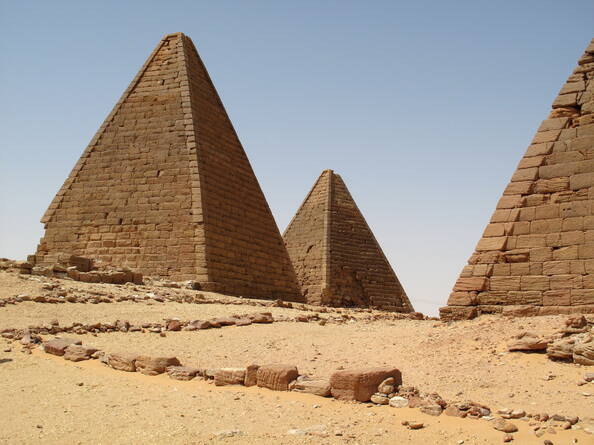Gebel Barkal y sitios de la región napatea
Gebel Barkal and the Sites of the Napatan Region
These five archaeological sites, stretching over more than 60 km in the Nile valley, are testimony to the Napatan (900 to 270 BC) and Meroitic (270 BC to 350 AD) cultures, of the second kingdom of Kush. Tombs, with and without pyramids, temples, living complexes and palaces, are to be found on the site. Since Antiquity, the hill of Gebel Barkal has been strongly associated with religious traditions and folklore. The largest temples are still considered by the local people as sacred places.
Description is available under license CC-BY-SA IGO 3.0
Gebel Barkal et les sites de la région napatéenne
Ces cinq sites archéologiques couvrent une région de plus de 60 kilomètres de long dans la vallée du Nil. Tous les sites sont de culture napatéenne (de 900 à 270 avant J.-C.) et méroïtique (de 270 avant J.-C. à 350 après J.-C.), de l’époque du second royaume de Kush. Les sites comprennent des tombeaux avec et sans pyramide, des temples, des bâtiments d’habitation et des palais. Depuis l’Antiquité, la colline de Gebel Barkal est demeurée intimement liée aux traditions religieuses et au folklore. Les temples majeurs y sont toujours considérés comme des lieux sacrés.
Description is available under license CC-BY-SA IGO 3.0
جبل البركل ومواقع المنطقة النوبية
تشغل هذه المواقع الأثرية الخمسة مساحة يفوق طولها 60 كيلومتراً في وادي النيل. وتحمل هذه المواقع كلها آثار الثقافة النوبية (900 - 270 قبل الميلاد) والمروية (270 قبل الميلاد – 350 ميلادية) السائدتين في ظل دولة كوش الثانية. وتتضمن هذه المواقع قبوراً مزوّدة بأهرام أو مجرّدة منها، بالإضافة الى معابد وأبنية سكنية وقصور. ومنذ عصور ما قبل التاريخ، ارتبط جبل البركل ارتباطاً وثيقاً بالتقاليد الدينية والفولكلور، اما المعابد الأساسية فلا يزال ينظر إليها كأماكن ذات طابع ميتولوجي.
source: UNESCO/CPE
Description is available under license CC-BY-SA IGO 3.0
博尔戈尔山和纳巴塔地区
博尔戈尔山和纳巴塔地区的5个考古遗址,分布在尼罗河河谷方圆60多公里的区域内,是库施第二王国纳巴塔文化(公元前900年到公元前270年)和麦罗埃文化(公元前270年到公元350年)的历史见证。在这5个遗址中,考古学家还发现了大量带有或不带有金字塔的陵墓、庙宇、居住区和宫殿等建筑物。博尔戈尔山自古就与宗教传统和当地民俗紧密相连。在当地人看来,博尔戈尔山最大的庙宇群至今仍然是极为神圣的地方。
source: UNESCO/CPE
Description is available under license CC-BY-SA IGO 3.0
Священная скала Гебель-Баркал и археологические памятники в области Напатан
Пять археологических зон, растянувшихся более чем на 60 км по долине Нила, являются свидетельствами культур Напатан (900-270 гг. до н.э.) и Мероэ (270 г. до н.э. - 350 г. н.э.) второго царства Куш. Здесь можно увидеть гробницы, с пирамидами или без пирамид, храмы, жилые комплексы и дворцы. С античных времен холм Гебель-Баркал тесно связан с религиозными традициями и мифологией. Крупнейшие храмы все еще считаются местными жителями священными.
source: UNESCO/CPE
Description is available under license CC-BY-SA IGO 3.0
Gebel Barkal y sitios de la región napatea
Este sitio comprende cinco áreas arqueológicas que se extienden por el valle del Nilo, a lo largo de una zona de 60 km de longitud. Todas ellas datan de la época del segundo reino de Kush y son exponentes de las culturas napatea (900–270 a. C.) y meroítica (270 a. C.–350 d. C.). Los vestigios arqueológicos comprenden tumbas, con pirámides o sin ellas, templos, viviendas y palacios. El monte Barkal ha estado estrechamente vinculado a las tradiciones religiosas y el folclore de la población desde la Antigüedad. Hoy en día, los templos más importantes se siguen considerando lugares sagrados.
source: UNESCO/CPE
Description is available under license CC-BY-SA IGO 3.0
ゲベル・バルカルとナパタ地域の遺跡群
ゲベル・バルカはスーダン北部、ナイル川第4急流の下流右岸、カレイマ近郊にそびえる山。ナパタ地方の聖地であり、約100mもの切り立った崖下に、長さ約60㎞にわたり多くの遺跡が残る。これらはヌビア遺跡の一部を構成するとも考えられ、ナパタ文化(紀元前900~同270年)とメロエ文化(紀元前270~紀元後350年)のもので、第2クシュ王国時代に遡る。山の西側にはクシュ王国メロエ時代のピラミッド群がある。遺跡には寺、宮殿、住宅街までが含まれる。source: NFUAJ
Gebel Barkal en de gebieden van de Napata regio
De Gebel Barkal en Napata regio bestaan uit vijf archeologische vindplaatsen, die zich uitstrekken over meer dan 60 kilometer in de Nijl vallei. Ze getuigen van de Napata (900 tot 270 voor Christus) en Meroïtische cultuur (270 voor tot 350 na Christus), in de tijd van het tweede Koninkrijk van Kush. In het gebied zijn graven – met en zonder piramides, tempels, wooncomplexen en paleizen te vinden. De heuvel van Gebel Barkal wordt sinds de oudheid geassocieerd met religieuze tradities en folklore. De grootste tempels worden nog steeds beschouwd als heilige plaatsen door de lokale bevolking.
Source: unesco.nl
